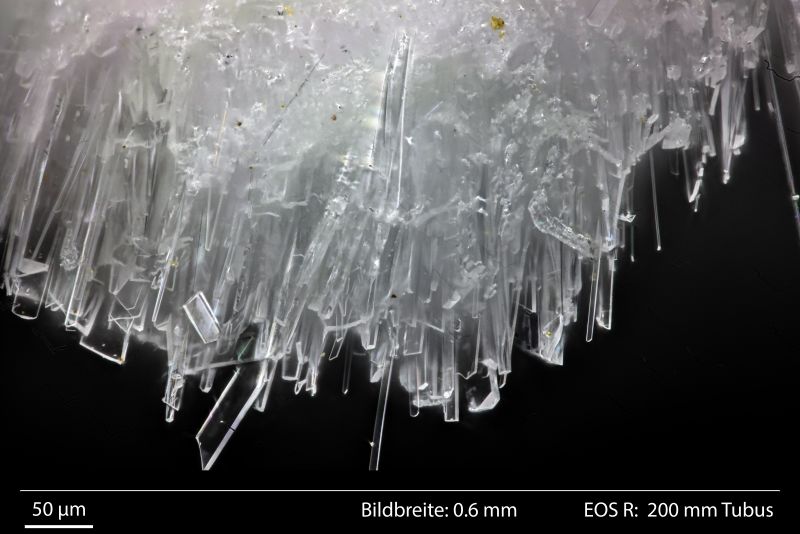
Forschung
Here we list an overview of our ongoing research projects and staff involved.
Nachstehend finden Sie eine Beschreibung unserer aktuellen Forschungsprojekte und der daran beteiligten Mitarbeiter. Bitte beachten Sie, dass die Projektbeschreibungen aufgrund des internationalen Charakters unserer Forschung auf Englisch verfasst sind.
Controls on saddle dolomite formation
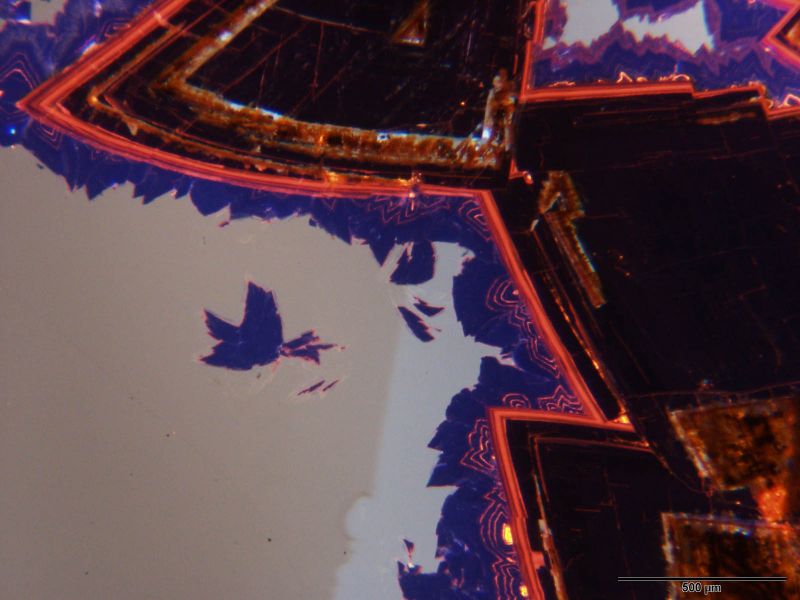
|
Saddle dolomites are Mg-carbonates with conspicuously warped crystal surfaces. Previous work has assigned saddle dolomites to the burial realm and fluid temperatures above 60°C. The crystallographic drivers, however, of the warped crystal surfaces are at present unknown. The project makes use of natural saddle dolomites and employs a series of analytical (geochemical and optical tools) to unravel the reasons for this peculiar feature. Staff involved: Yifan Zhang, M. Müller, S. Chakraborty and A. Immenhauser |
The four major Isotopes of Dolomite (C, O, Mg, Ca): Closing the Calcium Isotope Gap
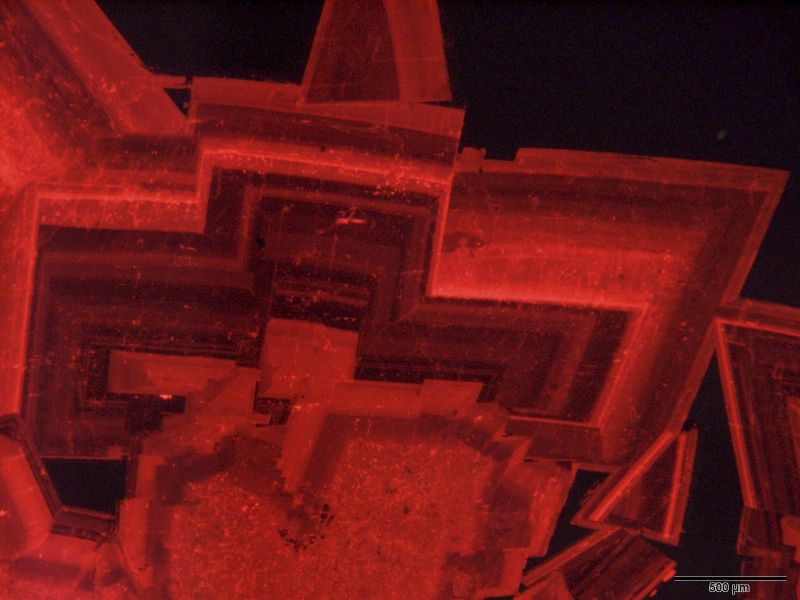
Dolomite is a rock-forming mineral that consists of calcium, magnesium and carbonate ions and naturally occurs in a variety of sedimentological and diagenetic environments. However, data on the calcium isotope signatures of dolomites remain scarce. This is relevant as non-stoichiometric dolomites, the bulk of dolomites in Earth's history, are often Ca-rich (molar ratio of Ca:Mg>1) and hence, Ca isotope (δ44/40Ca or δ44/42Ca) signatures clearly deserve attention. Previous work documented that the δ44/42Ca, δ26Mg, δ13C, and δ18O isotope signatures of a variety of early diagenetic dolomites/dolostones represent distinct diagenetic domains and time intervals. It is the objective of the project to (i) establish a well-constrained characterization of Ca isotope signatures for early diagenetic dolomite types, (ii) combine multi-proxy Ca, Mg, C, O (and stable Sr) isotope data in order to reduce noise and enhance the signal in data sets by assessing covariance patterns and (iii) assess the formation and diagenetic alteration of different stoichiometric dolomite types and their isotopic and elemental patterns relative to syn-sedimentary non-stoichiometric phases. Overall, it is the aim to provide the community with the foundations to establish a well-constrained palaeo-seawater archive.
Staff involved: S. Riechelmann, M. Dietzel, V. Mavromatis, V. Liebetrau and A. Immenhauser
Modern seawater properties and early marine cementation along the coast of Abu Dhabi
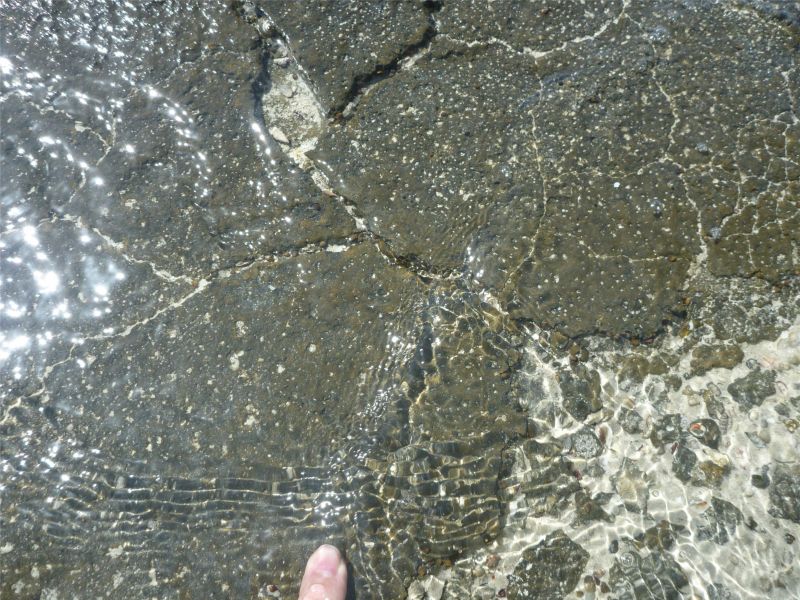
In the modern glacial world, the (sub)tropical Abu Dhabi coastal area represents one of the few analogues for ancient epeiric seas. The coastal area is characterized by hot and arid climate, shallow water depth, low topographic gradient, little terrestrial influx and active carbonate sedimentation. Furthermore, there are widespread and diverse early-marine cementation features in the Abu Dhabi coastal area. Therefore, the (sub)tropical active carbonate environment of the Abu Dhabi coast provides a unique opportunity to study: i) spatial variation and evolution of epeiric seawater properties and related geochemical proxies; ii) modern early-marine cemented features in the epeiric seas, and iii) the relationship between seawater properties and early-marine cementation. These aspects are relevant for the interpretation and reconstruction of paleo-marine environments from past epeiric carbonates.
Staff involved: C. Zhong, Y. Ge, C. Pederson, S. Lokier and A. Immenhauser
DGE-rollout of deep-geothermal energy in NW-Europe
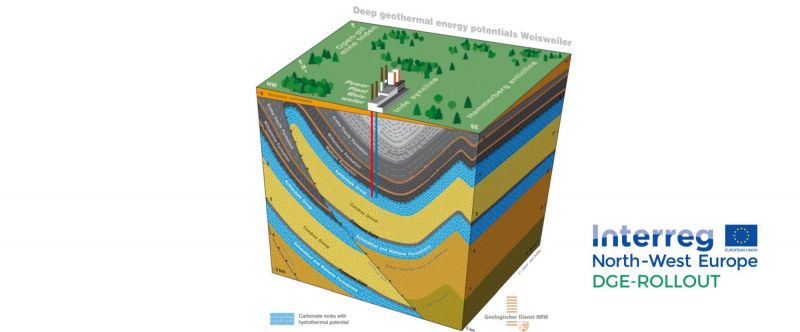
In an effort to reduce CO2 emissions in NW Europe, the exploration of deep geothermal energy (DGE) production to replace electricity and heat by burning fossil fuels is being researched through an EU-funded Interreg project called DGE-Rollout. However, the exploration of DGE in most NWE regions requires specific expertise and technologies in the complex geological situations (strongly faulted high permeable carbonates and coarse clastic rocks) that lie across the borders between Germany, France, the Netherlands and Belgium. It is the objective of DGE-Rollout to produce energy and reduce CO2 emissions by replacing fossil fuels through the increased usage of DGE in NWE for large-scale infrastructures requiring high-temperature heat supplies to cover their basic energy loads. This will be achieved by mapping and networking, by the application of innovative decission, exploration strategies, and testing for production optimization. Further activities will apply innovative decision and exploration strategies that cost less, reduce risks, are more reliable and will show a 3D Atlas of the complex geological situation as the spatial basis usable for DGE. The RUB will focus on working to better understand the response of the potential DGE reservoir unit, and help predict the evolution of the reservoir during production.
Staff involved: O. Uwakwe, S. Riechelmann, M. Müller, K. Lippert, C. Pederson and A. Immenhauser
External link: DGE-rollout of deep-geothermal energy in NW-Europe
Greener - Characterization and prioritization of geothermal reservoirs as energy carriers in the Rhine-Ruhr area
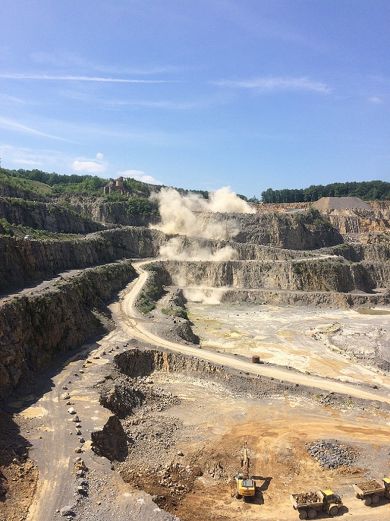
The conversion of the district heating network in the Rhine-Ruhr area from being fossil-fueled to being supplied by renewable energy carriers is a major task. Integrating deep geothermal reservoirs into the grid could provide a future solution. Potential geological formations in the Rhine-Ruhr area include the Carboniferous and Devonian carbonates at depths of 3,000 m to 5.000 m. The research project Greener aims to identify the spatial distribution of the Devonian reef-facies in the Rhine-Ruhr area and its respective geoscientific properties. An outcrop analogue study is conducted which includes field research like fault and fracture analysis etc. and subsequent laboratory examinations analyze the thermal, hydraulic, mechanical and chemical properties of the aforementioned stratigraphic units under surface and reservoir conditions. These correlations provide valuable information about the rock characteristics at a certain depth and thus the overall reservoir potential of the Devonian carbonates.
Staff involved: K. Lippert, A. Immenhauser, R. Bracke and M. Nehler
Assessing the resilience of carbonate archives of environmental change in limestone-to-dolostone transition zones
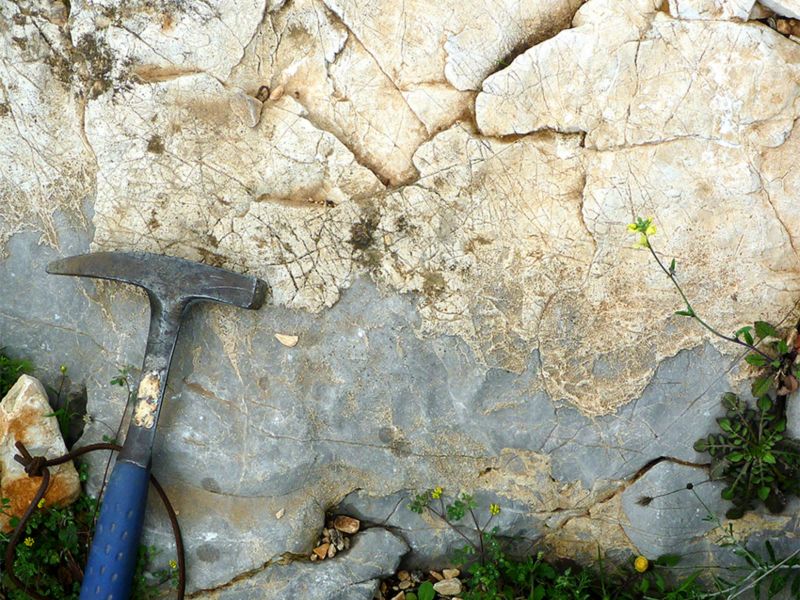
About 70% of Earth's geological history is recorded in carbonate archives that have seen varying degrees of post-depositional dolomitization. Limestone-to-dolostone transition zones are important due to the inherent depositional and diagenetic information they contain. The insufficient understanding of lateral and stratigraphic patterns within these transition zones forms a limitation in carbonate research. Similarly, early diagenetic dolomicrites, which typically record marine environmental conditions, are in the focus of this project. When altered, burial conditions may overprint the original signature but then at least provide information on burial pathways. The objective of this study is to establish a detailed framework for limestone-to-dolostone transition zones and early diagenetic dolomites from different time intervals. Upstream, a well-constrained Mg-isotope data set from all early (marine) to late diagenetic (burial) carbonate phases and complementary geochemical data constrained within fluid property context are aimed for. In foresight, this project intends to establish robust and quantitative benchmarks to test the validity of various environmental proxies in dolomitized limestones and their associated facies.
Staff involved: M. Müller and A. Immenhauser
Cephalopod shells as marine paleo-environmental recorder
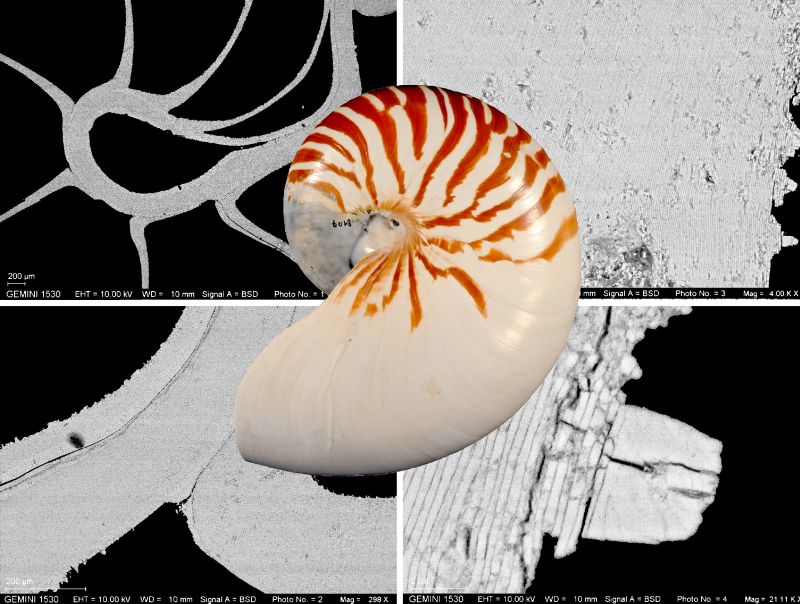
Biomineralized tissues of marine organisms can record seawater properties (e.g., temperature) during growth making them ideal candidates for the reconstruction of paleoenvironments. Due to the accretionary growth of, e.g., brachiopods and molluscs, changes of the organism's habitat are also recorded, which allows for the reconstruction of habitats and lifestyles of exctinct organisms. This project focuses on ammonoids and belemnites, both extinct cephalopod groups, and additionally on organisms that occur together with them in the same depositional environment. During the Jurassic and Cretaceous, transgressions/regressions as well as warming/cooling phases and oceanic anoxic events took place. This makes both time periods ideal for studying the appearance, disappearance and distribution of taxa, changes in shell shape, microstructures and geochemical proxies (e.g., δ18O, δ13C, δ44/40Ca). The main goals are to investigate the possible influence of changes of various paleo-ecological parameters (e.g., water depth, pH, temperature, oxygenation of the habitat zone) on marine organisms with respect to the temporal, geographical distribution, shell shape, geochemistry and microstructure.
Animated micro-CT of Nautilus pompilius
Staff involved: R. Hoffmann, S. Riechelmann, K. Stevens and A. Immenhauser
Cave carbonates from the Windloch (Germany)
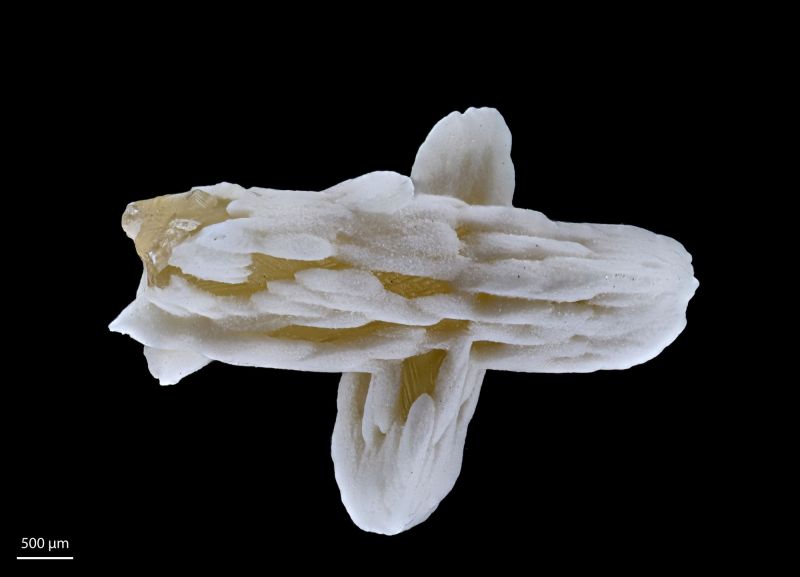
Cave carbonates of interest in this research project are cryogenic cave calcites (cryocalcites) and helictites (excentriques) from the 2019 discovered cave Windloch in Germany. Geochemical, petrographical, and crystallographical tools are used to gain insight into the formation conditions, whereas U/Th age dating provides information about the formation time. This project is performed in close cooperation with the Insitute of Geosciences, Johannes Gutenberg Universität Mainz and Arbeitskreis Kluterthöhle e.V.
Staff involved: S. Riechelmann, D. Buhl, A. Immenhauser, R. Hoffmann, D. Scholz (Universität Mainz) and S. Voigt (Arbeitskreis Kluterthöhle e.V.).
Precipitation experiments under cave analogue conditions
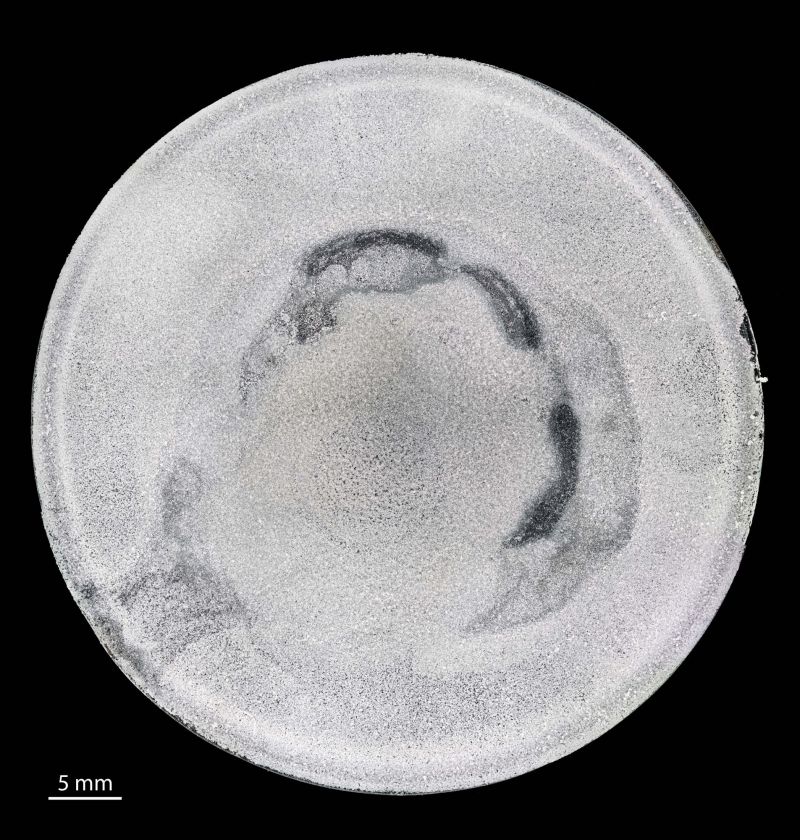
This project aims to precipitate carbonate crystals on watch glasses (closest to a stalagmite surface) in an experimental approach in the laboratory under cave analogue conditions in order to determine the influence of trace elements, organic compounds, and growth rate on calcite crystal morphology, crystal fabric, and the partition coefficient of different trace elements. Important tools for the realization of the project are the analysis of element concentrations, SEM, and EBSD.
Staff involved: O. Uwakwe, S. Riechelmann, D. Buhl, R. Hoffmann and A. Immenhauser
Magnesium isotope signature of dolomites
The goal of this research project is an improved understanding of the controlling factors of magnesium isotope (δ26Mg) fractionation in for instance speloan carbonates or bivalve hard parts. The main focus is on the potential of this novel isotope system as a paleo-climatological, paleo-ecological and paleo-oceanographic proxy.
Staff involved: S. Riechelmann, M. Müller, M. Dietzel (Graz) and A. Immenhauser
An experimental approach to cryogenic cave calcites
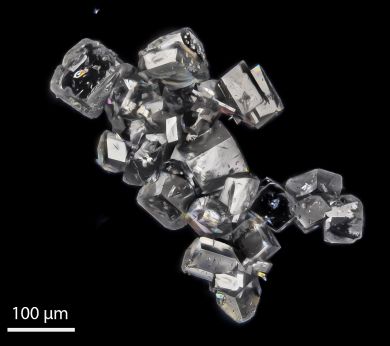
Cryogenic cave calcites (CCC) grow from freezing cave waters where slow freezing leads to a very light O-isotope composition and quick freezing leads to higher O-isotope composition. Calcites of the first group have formed in Middle European caves in water pools on ice during the transition from cold to warm periods. After the ice had molten, a polymict "crystal sand" of cryogenic calcite particles is found as a residue on the cave ground. According to morphological and structural criteria, these particles can be distinguished as spherolitic, rhombohedral crystal, plait and skeletal crystal sinters. Our work has a mainly experimental approach.
Staff involved: S. Riechelmann, O. Uwakwe and A. Immenhauser
Late Cretaceous calcareous nannofossils from northern Germany and their application in archaeology and geology
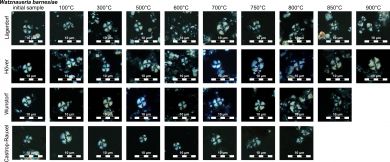
Light microscopic images of Watznaueria barnesiae of four sample sets (Lägerdorf, Höver, Wunstorf, Castrop-Rauxel), showing a progressive degradation with increasing temperatures
Mortar is the essential binding agent of human buildings all over the world. For producing mortars, three different components are utilised: a binder (lime, gypsum, mud, cement), aggregates (e.g. sand, rock fragments) and additives (pozzolans, organic materials). Lime, gypsum and mud are the three most common and historically oldest binding materials used for man-made constructions. Lime-based mortar consists of quicklime, which is produced by burning naturally occurring limestones at > 800°C. Calcareous nanno- and microfossils are not expected to be present in lime binders of mortars and mortar-based materials due to the high heating temperature. They have, however, been detected in thin sections, SEM images and smear slides of mortars.
The three main objectives of this project are to (i) establish the use calcareous nannofossils for provenance analysis of historic mortars, (ii) gain experimental data on the behaviour of calcareous nannofossils with increasing temperature related to the burning procedure and (iii) to use the experimental data on historic mortars to reconstruct the burning temperature during quicklime production. This project will thus contribute to a better understanding of historic mortar production.
Staff involved: J. Falkenberg and J. Mutterlose